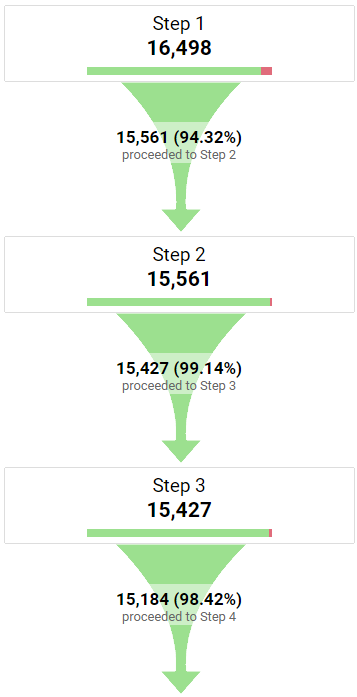What Data Is Google Analytics Goals Unable to Track: Important Information
What Data Is Google Analytics Goals Unable to Track: Important Information
Blog Article
Revealing the Blind Attractions: Understanding What Google Analytics Goals Can not Measure
In the realm of electronic analytics, Google Analytics stands as a powerful device for monitoring and examining online user interactions. Recognizing what Google Analytics goals can not measure is critical for acquiring a detailed view of customer habits and interaction.
User Actions on External Operatings Systems
Understanding how customers communicate on exterior platforms is critical for optimizing online approaches. External platforms, such as social media networks, reference sites, and on-line forums, play a substantial function in driving website traffic to a business's web site. By evaluating customer behavior on these systems, businesses can obtain beneficial understandings right into the effectiveness of their advertising initiatives and the preferences of their target market.
One secret facet of user habits on exterior platforms is the recommendation source. By tracking where the customers are originating from, businesses can determine which systems are driving one of the most traffic to their website. This info can assist companies designate their sources extra effectively, focusing on the platforms that yield the most effective outcomes.

Offline Communications and conversions
Evaluating customer habits on external systems supplies important understandings into on-line methods; however, thinking about offline conversions and communications is equally critical for a detailed understanding of a firm's overall efficiency. Offline conversions, such as in-store acquisitions or phone questions, play a considerable role in lots of services' success.

Attribution Beyond Last Click
When diving right into the world of digital advertising analytics, it becomes important to look past the single touchpoint of the last click for a more extensive understanding of attribution. While Google Analytics gives useful insights into individual habits, counting exclusively on last-click acknowledgment can be restricting - what data is google analytics goals unable to track. Acknowledgment models that exceed the last click use a much more nuanced view of the customer trip, thinking about all the touchpoints that result in a conversion
Attribution past the last click permits marketing experts to assign debt to various interactions along the conversion course, giving a more clear image of the effectiveness of different marketing channels. By discovering multi-touch acknowledgment versions such as linear, time degeneration, or position-based attribution, businesses can much better assign their advertising budgets and maximize their strategies for optimal impact.
Recognizing the influence of each touchpoint browse around this site in the conversion procedure is crucial for making educated choices and maximizing ROI. By accepting acknowledgment past the last click, companies can gain much deeper insights into customer behavior and tailor their marketing efforts better.
Cross-Device and Cross-Browser Tracking
Similarly, cross-browser monitoring matches cross-device tracking by capturing customer habits as they switch over in between various internet internet browsers. Recognizing exactly how users communicate with sites on numerous browsers can assist marketing experts optimize their online experiences to make sure consistency and capability across different platforms.
Qualitative Information and Individual Intent
Understanding individual intent through qualitative data analysis is important for establishing targeted digital advertising strategies that reverberate with the demands and preferences of the target market. Qualitative data supplies insights into the 'why' behind customer activities, dropping light on motivations, feelings, and preferences that quantitative information alone can not record. By evaluating customer feedback, comments, and communications, online marketers can discover important info concerning customer intent, allowing them to tailor their messaging, material, and offerings to better straighten with what their audience is seeking.
Qualitative data also helps in understanding the context in which individuals involve with a website or app. This contextual understanding makes it possible for marketing experts to create more individualized and relevant experiences, eventually driving higher involvement and conversion rates. By diving into user intent via qualitative data evaluation, organizations can get a deeper understanding of their target market, resulting in much more efficient advertising and marketing more tips here methods that fulfill individuals' expectations and requirements.
Final Thought
In conclusion, Google Analytics objectives have constraints in determining user habits on external systems, offline conversions, attribution past last click, cross-device and cross-browser monitoring, and qualitative information connected to user intent. what data is google analytics goals unable to track. It is essential for services to be aware of these blind places in order to supplement their information evaluation click here for more info with various other devices and approaches to obtain an extra comprehensive understanding of their target market and boost their total electronic advertising and marketing approaches
By assessing individual habits on these platforms, organizations can get useful understandings right into the efficiency of their advertising and marketing efforts and the choices of their target audience.
Assessing individual actions on exterior platforms gives valuable understandings into on the internet methods; however, thinking about offline conversions and interactions is equally vital for an extensive understanding of a business's total efficiency.In digital advertising analytics, moving past last-click acknowledgment to explore cross-device and cross-browser monitoring is crucial for getting an all natural understanding of user communications throughout numerous systems and tools. By examining individual responses, remarks, and interactions, online marketers can discover important details regarding individual intent, enabling them to customize their messaging, content, and offerings to better align with what their target market is seeking.
By delving into user intent with qualitative information evaluation, organizations can get a deeper understanding of their target audience, leading to more efficient advertising and marketing methods that satisfy users' demands and expectations.
Report this page